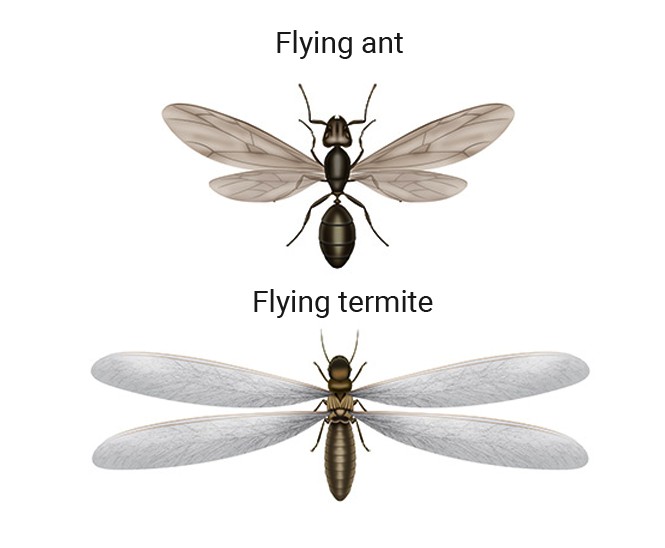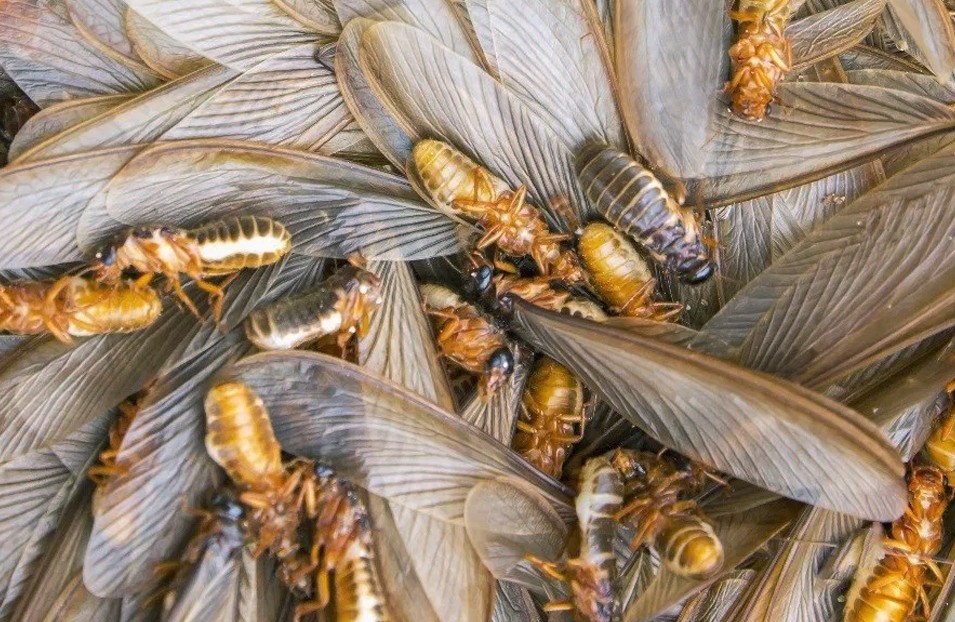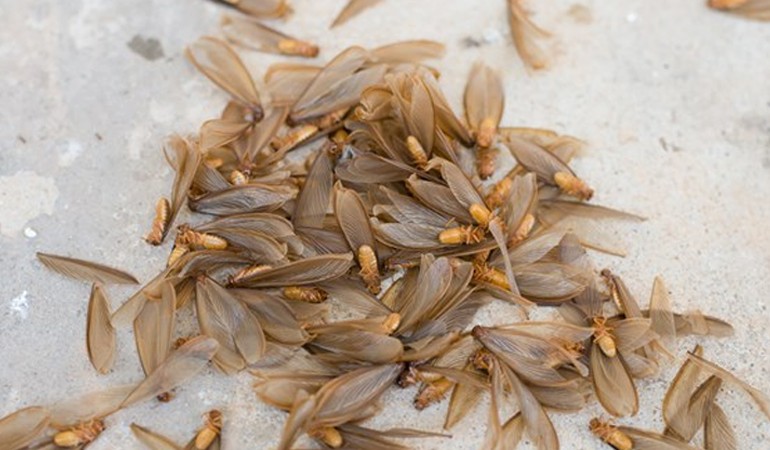Flying Termites

What are Flying Termites?
You all must be aware of the insidious creatures called termites, known infamously for damaging your house properties, but what are these flying termites all about? Known as Alates (winged reproductives) or Imagos scientifically, flying termites can cause just as much the damage as the grounded ones.
The primary purpose of the flying termites that consist of either males or females is to build new colonies and become either the King or Queen in the future of the newly built nest. If you spot a number of Alates inside your home, you will also notice that the flying termites shed their wings around your windows and doors. This could be an indicator of a flying termite swarm in a nearby yard, or some other close location, or your home itself.
Can all Termites fly?
Termites typically have three castes, or let’s say, groups, within the whole termites’ colony! Now the Flying Termites belong to the Alates caste. The other two are called the soldier termite and the worker termite. Looking at the whole caste, you must know that only the Alates can fly, and not the other two. The Alates are also known to be the reproductive caste. This is because these are the only kind of termites that are developed sexually to be able to reproduce. They’re also the only ones to have wings. As they mature, the males become colony kings and females become colony queens.
Hold on. There is more! Did you know the Alates can also fly only for a brief period of time and not forever? This leads to them depending on their legs in order to move around just like the other termites who count totally on their six legs for locomotion because they have no wings. The soldier termites, however, have heavier and larger legs.
What do the Flying Termites look like and How to Identify them?

Picture of Flying Termites
Flying Termites are so tiny that they become difficult to identify by us humans. Most of us have at least once mistaken them for ants as they look quite similar. However, you can successfully identify the flying termites keeping these in mind:
- Termites have straight antennae, while ants have them bent.
- They have a straight waist as well and the Flying Termites have wings of the same size.
- The adult reproductive termites appear to be black or dark brownish in color and are about one-fourth to three-eighths inches long. Their wings seem too big for them though as they extend beyond their bodies.
Why do the Flying Termites Swarm?
The rainy season is succeeded by a dry spell, and that’s when the typical swarming season starts, and it occurs mostly at or after dusk. If you do not understand what ‘swarming’ means, let us tell you it is a natural phenomenon that takes place as a subterranean termite colony grows to be of a size that’s considered ‘matured,’ or usually about 3-4 years old. When you witness these huge flying termite swarms, it can look very intimidating; however, they do not really cause any structural destruction and aren’t aggressive.
It depends on the flying termite’s species to conclude whether their swarm will occur once or multiple times per colony, in a year. If you consider rural areas, swarms congregate mostly around lights and can be a big number. It is interesting to note winged termites are produced once the colony is matured, and then the swarm leaves their home to look for mates to build new colonies. After the process of fertilization, termites with wings go towards the ground where they shed their wings in an attempt to start a new colony.
Flying Ants vs Flying Termites

Difference between Flying Ants and Flying Termites
Because of their tiny size and the presence of wings, some flying ants are mistaken for as the winged-swarming termite, and vice versa. Here are some features that will help you differentiate between the flying ants and termites.
If you notice the antennae of both of these creatures, you’ll find that the termites have a straight one, the ants have it elbowed.
Also, if you take a look at the wings, you will see while the wings of a termite are always uniform in size; the front pair of wings of the flying ants is larger than the back pair. To add onto this point, you must know that the wings of the termites are two times longer than their body, whereas, in case of ants, the wing size is almost proportionate to their bodies.
Again, ants’ bodies appear segmented because of the apparent twitch in between their thin waists, whereas termites have a broad waist having almost a uniform or similar width along their full body.
What are the health risks associated with termites?
Well, termites may end up stinging or biting you when provoked, but be rest assured the wounds caused by them aren’t toxic. They are not even known to carry around diseases that may be harmful to the health of humans.
However, people who suffer from termite infestation at their homes may suffer from asthma attacks or allergic reactions due to the pesticides used to repel them. Flying termites are popular for destroying your homes, but they cannot harm you directly.
How to get rid of Flying Termites?
You can think of wood when it comes to termites, and to get rid of them, you would obviously have to take extra care of the wooden properties that you have. Damaged timber or timber that has a contact with the ground can lead to moisture build-up in the wood which can further attract the termites like a magnet. You have to keep inspecting your house regularly to prevent a termite infestation.
- Remember that mulch should not be around your home’s foundation
- You should check for damaged wood and mud tubes on the outside areas of your home like the subfloors and basement regularly
- The attics, crawl spaces and the basement again should be well ventilated and kept dry always
- Follow good maintenance and housekeeping habits and repair damages related to fascias, roof tiles, soffits, and so on
- You can use the parasitic nematodes found online or at drug stores to kill termites. These nematodes are worms that love feeding on the latter.
- Make sure to avoid accumulation of water at your homes that occurs mainly due to rainwater
- Sunlight kills termites naturally with its UV rays. You can place termites’ infested furniture under sunlight to accelerate the death of termites
- If you cannot cut down on wood because of your love for it, at least keep the structures protected by performing wooden treatments like using sprays or paints that are resistant to termites
- If all else fails, get a professional termites control done, to nip the termites in the bud.
Pictures
Take a look at few pictures of flying termites…



Amazing Facts
Here are some interesting facts about the Termites in general:
- Across the world, there are more than 2700 species of termites
- If you do some ecological talking, termites are highly beneficial and not harmful. They act as significant decomposers as they break down plant fibers and recycle dead and decaying trees into new soil, which is vital for maintaining forest health. Their tunneling also helps to aerate the soil and thus improve it.
- You’d be a little disgusted to know that termites feed on each other’s feces (read poop), and this practice is scientifically called trophallaxis
- Termites never ever sleep! They work to build their colonies day in and out until they are dead
- It is not easy to believe this, but termites cause damage to property that is worth more than 5 billion dollars, every year
- Termites are ‘euro social’ just like ants meaning they follow the caste system, where every group or caste have their own roles to play
- The worker termites bring up digested cellulose into the mouths of the reproductive and the soldier castes’ termites to feed them. This is because such castes are incapable of feeding themselves
- Termites, not just enjoy eating wood but they like eating fabrics, wallpaper, and plastic sometimes too
- Termites believe in keeping each other groomed in the colonies, and they also spend a considerable amount of time in doing so to ensure preventing any kind of disease in the colonies. They are very, very hygienic insects
- There are some varieties of termite species that have been on earth for more than 250 million years now
- Termites use chemical scents called pheromones to communicate, talk to, and control each other’s behavior as well
- Did you know there are a few termite species’ queens who have the ability to lay 15-25 eggs per minute, and sometimes about 40,000 eggs in a day, and up to 10 million eggs a year? Also, termite queens are known to live the longest in the world of insects. Some of them can live between 30 to 50 years.
- Termites make up for good food that’s high on nutrients because they are loaded with proteins, calcium, iron, fatty, and amino acids
- Ants are the termites’ primary enemies/competitors and predators
- As per records, the largest termite colony had more than three million termites
Sure, termites are creepy, and they wreak havoc when it comes to your furniture, but we are confident you didn’t know so much about them, or more specifically the ‘Flying Termites’ before reading this article. Spread the word guys!
